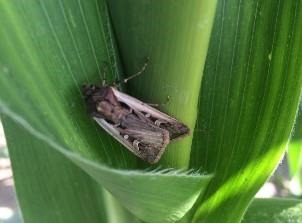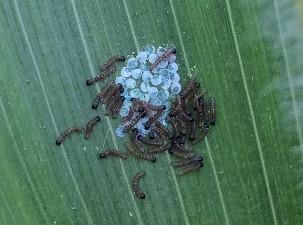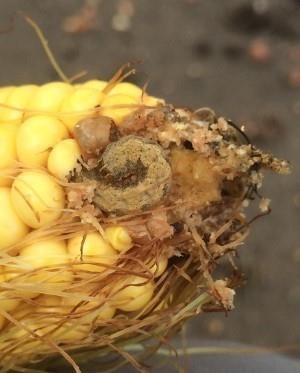By Julie Peterson and Robert Wright et.al
The first western bean cutworm moths (Figure 1) were captured in University of Nebraska-Lincoln black light traps at Clay Center on June 21, Scottsbluff and Concord on June 23, and both North Platte and Mead on June 25-27. Flights have increased over the past two weeks and reports of egg laying (Figure 2) have come from south central, central, west central, and southwestern parts of the state. As the moth flight continues and egg masses are laid in crops, it is essential to scout fields for the white to purple, dome-shaped eggs (Figure 2) and young larvae (Figure 3).

Figure 1. Western bean cutworm moth (all photos by Julie Peterson)
Figure 2. Western bean cutworm egg mass; shaped like a basketball, whereas the similar-looking stink bug eggs are taller and shaped like barrels.
Figure 3. Recently hatched western bean cutworm larvae near their egg mass.Based on light trap data, observations of egg masses in the field, and degree-day predictions, we are recommending that scouting begin immediately for western bean cutworm across the state of Nebraska. Scouting should be prioritized in fields that are at the preferred growth stage for egg-laying (late whorl to early tassel) and/or do not have the VIP3A Bt trait to protect them from western bean cutworm injury.
Scouting
When scouting for western bean cutworm in corn, you can save time by using UNL’s speed-scouting mobile app or spreadsheet. Benefits include:
- Paperless scouting with real time, in-field decision support.
- A visual aid in identifying western bean cutworm egg masses.
- Scouting data storage so you can review information without having internet access.
- A reminder for when future scouting should be conducted.
The app is available for iPad, iPhone, iPod Touch, and Android devices. This free app can be downloaded from the Apple App Store or Google Play by searching "western bean cutworm." It is also available as a downloadable Excel spreadsheet, Western Bean Cutworm Speed Scouting, EC1585.
If you are not using the speed-scout tool, check 20 plants in at least five areas of each field. Look for eggs on the top surface of leaves in the upper one third of the plant and larvae in the tassel or leaf axils. Western bean cutworm moths prefer to lay eggs in corn plants that are in the late whorl stage to early tasseling compared to those that have completely tasseled. Pay particular attention to later planted fields or those with uneven development. Western bean cutworm eggs that hatch when corn plants are in the late whorl stage of growth have a high rate of survival. The larvae are well protected in the whorl or tassel and fresh tassels provide the best food source for early instar larvae.
If western bean cutworm eggs hatch when corn plants are in the late whorl to early tassel stage of growth, survival will be highest.
More information on scouting and western bean cutworm biology can be found in the NebGuide, Western Bean Cutworm in Corn and Dry Beans (G2013).
Treatment Recommendations
There is just one type of Bt protein that provides reliable protection against western bean cutworm: VIP3A. Products that express the VIP3A protein, such as Agrisure Viptera, Leptra, and Trecepta, provide effective control and should not need to be treated, although it is always advised to scout and inspect Bt cornfields to ensure adequate efficacy. See the Handy Bt Trait Table for a list of commercially available Bt corn hybrids and the proteins they express.
The Cry1F protein has provided protection against WBC in previous years, with approximately 80% control of western bean cutworm when it was first released in 2003. However, this protein has lost efficacy in the last ~12 years due to the development of resistance. Cry1F is present in products such as Herculex 1, Herculex XTRA, AcreMax, and SmartStax. It is now recommended that fields with Cry1F products be scouted for western bean cutworm and insecticide treatment considered if above the economic threshold.
For corn hybrids that do not provide Bt control of western bean cutworm, consider applying an insecticide if 5-8% of the corn plants have egg masses or larvae. If an insecticide treatment is warranted in corn, it should be made when 95% of the plants in a field have tasseled. This application timing increases the chance that larvae will be exposed to the insecticide, resulting in better control. If larvae have already moved into the ears (Figure 4), they will be protected from insecticide by the husks and cannot be effectively controlled.
 Figure 4. Western bean cutworm larva feeding on corn ear.
Figure 4. Western bean cutworm larva feeding on corn ear.Aerial application or chemigation (if nozzles are above the height of tassels) have provided good control for this insect if applied before larvae enter the ear. Nozzles do not necessarily need to be above the height of the tassels for chemigation if the irrigation system has chemigation nozzles installed. Chemigation nozzles help ensure application into the upper plant canopy through water (or other water-carried products).
 Figure 5. Convergent lady beetle providing biological pest control by eating a western bean cutworm egg mass.
Figure 5. Convergent lady beetle providing biological pest control by eating a western bean cutworm egg mass.Carbamates (Sevin), spinosyns (Spinosad), methoxyfenozides (Intrepid), diamides (Prevathon), indoxacarb (Steward) and many pyrethroids (>50 commercial products) are labeled for control of western bean cutworm. Although organophosphates can also be effective, the application of chlorpyrifos products are not recommended due to the revocation of food and feed tolerances for this insecticide (see CropWatch article for more info). Consider rotating the mode of action in areas where pyrethroids have been heavily used for western bean cutworm and western corn rootworm control. The potential for resistance to commonly applied active ingredients such as bifenthrin and zeta-cypermethrin is a concern. Some insecticides, such as Prevathon and Steward, have been shown to have a lower impact on beneficial insects (such as lady beetles and lacewings). Preserving these predators in the field can provide some natural control of WBC eggs and larvae (Figure 5).
A list of registered insecticides, rates, preharvest intervals, and grazing restrictions is available in the Insect Management section of the most recent Nebraska Extension Guide for Weed, Disease, and Insect Management in Nebraska (EC 130).
Source : unl.edu